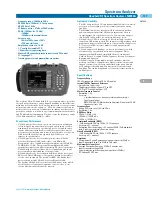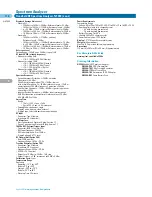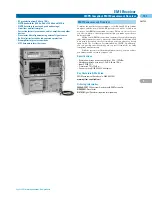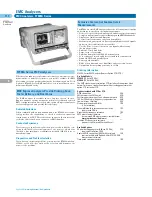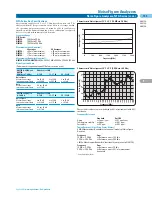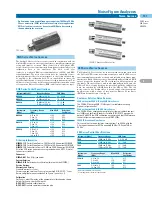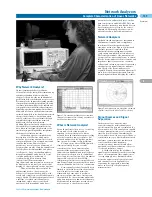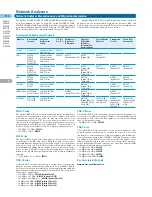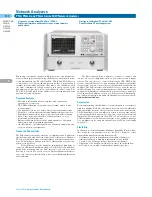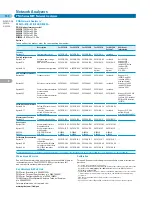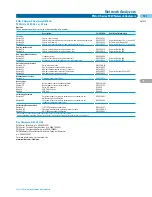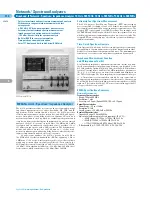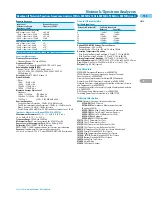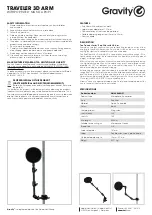
150
3
Overview
Complete Characterization of Linear Networks (cont.)
Network Analyzers
English URL
www.agilent.com/find/products
Broadband and Narrowband
Detection
After the desired signals have been
obtained from the test set, they must be
detected by the network analyzer; Agilent
network analyzers can use one of two
detection methods. Broadband detection
accepts the full-frequency spectrum of the
input signal, while narrowband detection
involves tuned receivers that convert CW or
swept-RF signals to a constant-IF signal.
There are certain advantages to each
detection scheme.
Scalar analyzers usually employ
broadband detection techniques.
Broadband detection reduces instrument
cost by eliminating the IF section required
by narrowband analyzers but sacrifices
noise and harmonic rejection. However,
noise is not a factor in many applications.
Finally, broadband systems can make
measurements where the input and output
signals are not of the same frequency, as in
the measurement of the insertion loss of
mixers and frequency doublers.
Vector network analyzers normally
employ narrowband detection techniques.
Narrowband detection makes a more
sensitive low noise detection of the constant
IF possible. This allows increased accuracy
and dynamic range for frequency-selective
measurements (as compared to broadband
systems).
Vector network analyzers can vary with
their employment of broadband, narrow-
band, or both types of detection. When both
types of detection are available, the user
selects the detection method, which allows
optimization of the device measurements.
Signal Processing and Display
Once the RF has been detected, the network
analyzer must process the detected signals
and display the measured quantities (see
Figure 3). All Agilent network analyzers are
multi-channel receivers utilizing a refer-
ence channel and at least one test channel;
absolute signal levels in the channels,
relative signal level (ratios) between the
channels, or relative phase difference
between channels can be measured,
depending on the analyzer.
Relative ratio measurements are
usually made in dB, which is the log ratio of
an unknown signal (Test Channel) with a
chosen reference signal (Reference
Channel). This allows the full dynamic range
of the instrumentation to be used in measur-
ing variations of both high- and low-level
circuit responses. For example, 0 dB implies
the two signal levels have a ratio of unity,
while ±20 dB implies a 10:1 voltage ratio
between two signals.
All network analyzer phase measure-
ments are relative measurements with the
reference channel signal considered to have
zero phase. The analyzer then measures the
phase difference of the test channel with
respect to the reference channel.
Phase information complements
amplitude data in the measurement of device
parameters. Phase is more sensitive to network
behavior and it is a required component of
complex impedance and transfer functions.
Phase data is also required to measure
delay distortion or group delay of networks.
Delay distortion occurs when different fre-
quency components of a complex waveform
experience nonlinear phase shifts as they
are transmitted through a network. Group
delay (see Figure 4) is a measure of this
distortion and is defined as:
An alternative method for measuring
phase distortion is deviation from linear
phase or differential phase. Deviations
from linear phase can be measured by
introducing enough electrical length in the
network analyzer’s reference channel to
linearize a device’s phase shift. This is
usually accomplished by using the electrical-
delay feature of the network analyzer, which
cancels the average electrical length of a
device mathematically.
Figure 3:
Simultaneous measurement of transmission
response and passband reflection return loss.
Scattering parameters, or S-parameters,
were developed to characterize linear
networks at high frequencies. S-parameters
define the ratios of reflected and transmitted
traveling waves measured at the network
ports. A two-port device is modeled with
S-parameters (see Figure 5). S
11
is the
complex reflection coefficient at port 1, and is
the ratio of b
1
/a
1
, if a
2
= 0 (port 2 terminated
in its characteristic impedance). S
21
is the
complex transmission coefficient from port
1 to port 2, b
2
/a
1
, if a
2
= 0. The “a’’ and “b’’
signals represent the amplitude and phase of
the incident and emerging or reflected
traveling waves. By reversing the ports and
terminating port 1 in its characteristic
impedance, S
22
and S
12
can be similarly
defined.
Additional Capabilities
Precision design work and manufacturing
tolerances demand highly accurate
measurements, but most errors in network
measurements are complex quantities that
vary as a function of frequency. By
characterizing and virtually removing these
systematic errors, measurement accuracies
are improved by several orders of magnitude.
Agilent network analyzers contain built-in,
high-speed computational hardware that can
perform the complex mathematics required
for sophisticated error correction.
Computer-controlled network
analyzers can be programmed to set up and
make many measurements automatically.
The measurement process is further
accelerated by the computer’s ability to
store, transform, summarize, and output
data in a variety of formats to a number of
peripherals. These capabilities make the
computer-controlled network analyzer ideal
for both computer-aided design or automatic
production testing. Several products have
built-in automation features, including GP
Instrument BASIC. The PNA family of
network analyzers have an integrated
Windows® operating system. This provides
the user with powerful computer control
directly in the network analyzer.
Figure 5:
S-parameter model for a two-port
linear network.
Tgd =
d
d
–
Figure 4:
Direct measurement of group delay with
digital readout at marker.
Summary of Contents for All
Page 1: ......


